Alaska Fish & Wildlife News
November 2025
Judging A Full-Curl Ram
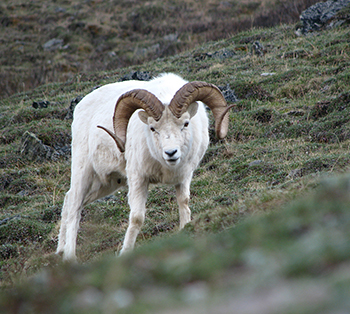
Late summer and early fall is a busy time around the Copper River Valley in Interior Alaska as hunters steal away to their secret high mountain terrain in search of elusive full-curl Dall sheep rams. Simultaneously, biologists at Glennallen’s ADF&G office prepare to process each ram skull brought in for sealing to determine compliance with the State of Alaska full-curl requirement.
Because judging whether a ram in the field and over great distances is “at least eight years old” or that “the tip of at least one horn has grown through 360-degree of a circle described by the outer surface of the horn, as viewed from the side” is very difficult, ADF&G developed a field guide for sheep hunters designed to help inform their in-field decision-making process, to help ensure harvest regulation compliance, and for improved hunting success.
Three Methods of Judging in the Field
The guide prescribes three methods to gauge whether a ram meets the 360-degree full-curl requirement. First is 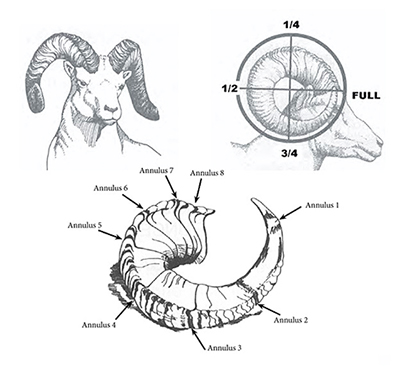 the Perfect Circle Test, where a ram’s horn is viewed from the side at such an angle that the outer surface of the horn forms a perfect circle (not an ellipse). If the horn tip meets or passes the horn base when viewed in this perfect circle position, it has passed the Perfect Circle test. Only one horn on a ram must be 360-degree to be legal. However, judging this for a close to full-curl ram while in the field and from a distance, given that the ram may move its head and change the viewing angle, makes the Perfect Circle Test very challenging to accurately determine at best.
the Perfect Circle Test, where a ram’s horn is viewed from the side at such an angle that the outer surface of the horn forms a perfect circle (not an ellipse). If the horn tip meets or passes the horn base when viewed in this perfect circle position, it has passed the Perfect Circle test. Only one horn on a ram must be 360-degree to be legal. However, judging this for a close to full-curl ram while in the field and from a distance, given that the ram may move its head and change the viewing angle, makes the Perfect Circle Test very challenging to accurately determine at best.
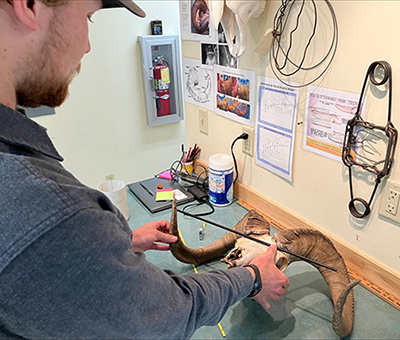
The second method specified by ADF&G to aid in determination of the full-curl requirement is the Stick Test. In the field, hunters apply an imaginary straight line across the forehead of the ram. Placement of the line is at the base of both horns with the line extending straight out past the horn tips on both sides. Again, proper viewing angle is critical to correctly gauging whether the ram meets the full-curl requirement; the correct angle will present with an equal amount of horn both above and below the stick. Head movement is ever challenging. However, if a hunter achieves the proper viewing perspective with equal amounts of horn both above and below the straight line and at least one of the horn tips meets or exceeds the plane of the line, it qualifies as a legal full-curl ram.
The third method recommended for assessment in the field is the Horn Base / Tip Angle Test. With this method, if the angle of the horn tip (1/2” down from the tip) aligns with or surpasses the angle of the horn base (determined by an imaginary straight line placed against the first two ridges up from the horn base), forming a 360-degree circle or beyond 360 degrees, the ram is full-curl. If the angle of the horn tip does not meet (or exceed) the angle of the horn base (on either horn), the ram does not pass the Angle test.
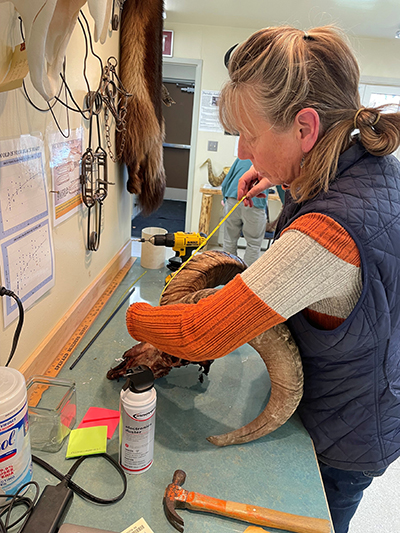
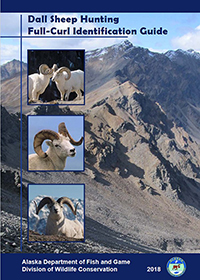 ADF&G’s pocket-sized field guide provides detailed explanations, photographs, and graphics for aid in applying these three test methods while in the field, in addition to other pertinent Dall sheep hunting information and recommendations. A hardcopy guide is available in all ADF&G offices and on ADF&G’s website under the title Dall Sheep Hunting Full-Curl Identification Guide.
ADF&G’s pocket-sized field guide provides detailed explanations, photographs, and graphics for aid in applying these three test methods while in the field, in addition to other pertinent Dall sheep hunting information and recommendations. A hardcopy guide is available in all ADF&G offices and on ADF&G’s website under the title Dall Sheep Hunting Full-Curl Identification Guide.
Ram Check-in 2025
During the recent 2025 sheep harvest season, the Glennallen ADF&G office checked-in a total of 37 rams harvested from Units 11, 12, and 13 for careful and detailed scrutiny of true annuli to determine age, and hands-on standardized testing methods (described above) to determine if a ram met full-curl requirements by at least one of these accepted full-curl tests.
Unit 11 rams that are harvested by federally-qualified subsistence users are not held to the full-curl requirement; however, 19 of the 25 rams from Unit 11 that came through the Glennallen office were considered full-curl either by virtue of their age (n=13) or by having met one of the standardized full-curl tests (n=6).
Unit 13 rams checked in at the Glennallen office were five in total, as many Unit 13 rams are sealed in other ADF&G offices. One of these five was considered a legal ram by virtue of its age. Two were legal based on location of harvest within a Unit 13 Draw Permit area that allowed any size ram to be taken. Two rams were determined legal based on at least one of the three full-curl tests. One did not meet either the age or full-curl test requirements.
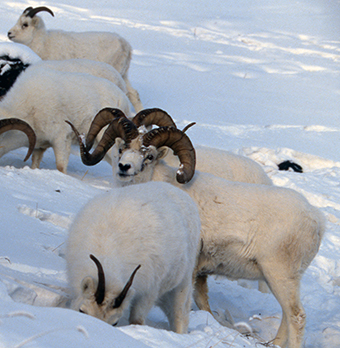
From every aspect, pursuit and harvest of a full-curl ram is physically demanding and mentally challenging; consequently, ADF&G encourages all sheep hunters to become thoroughly informed and prepared to determine full-curl status as described in the Dall Sheep Hunting Full-Curl Identification Guide. ADF&G believes that the majority of sublegal ram harvest can be avoided with adequate knowledge and preparation ensuring careful scrutiny of rams in the field. Stop by the Glennallen office or give us a call if you have questions about sheep hunting in Units 11 or 13!
Kari Rogers is the Program Technician in the Glennallen ADF&G office and supports the Division of Sport Fish and the Division of Wildlife Conservation. She wrote this originally for publication in the “Tales from the Tundra” feature in the weekly Glennallen area newspaper, The Copper River Record.
Dall Sheep Hunting Full-Curl Identification Guide PDF
Subscribe to be notified about new issues
Receive a monthly notice about new issues and articles.
